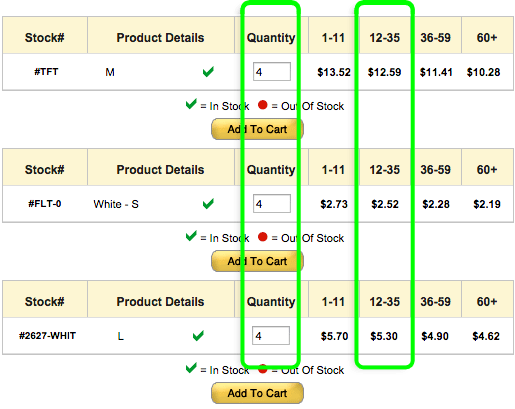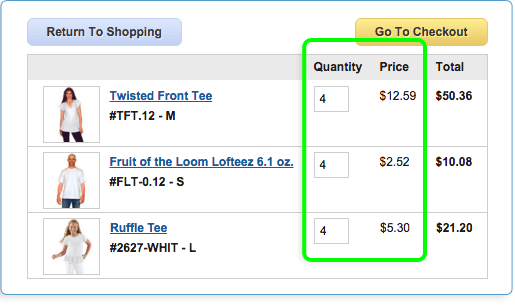|
Tie-Dye resist techniques have been practiced around the world in many forms for centuries. There are the Traditional Japanese Shibori, Indian Bandhana, and Indonesian Plangi or Tritik, also the weaving of resist dyed warps and wefts called Ikat. Ancient examples have been found in South America as well. These traditional techniques were known of in the US by the early 1900s but the techniques and fabrics were still very much connected with their regions of origin. Anyone practicing these crafts was carrying on the traditions of their culture. So how did the style of tie-dye we associate with American Tie-dye come to be?
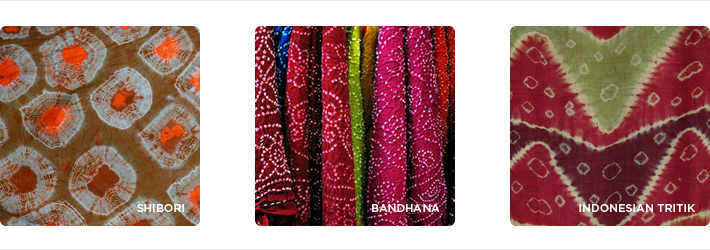
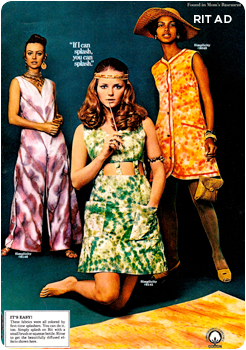 It all started back in the 60s as an attempt to save a brand name. At the time, RIT® dye was starting to lose it's market; primarily older women that dyed home goods. RIT was (and still is) mainly sold through supermarkets and craft stores. The management at RIT was faced with the challenge of trying to save the brand without spending much money to do so. The manager of RIT at the time, Don Price, determined to find an entirely new use for RIT dye and save the brand. It all started back in the 60s as an attempt to save a brand name. At the time, RIT® dye was starting to lose it's market; primarily older women that dyed home goods. RIT was (and still is) mainly sold through supermarkets and craft stores. The management at RIT was faced with the challenge of trying to save the brand without spending much money to do so. The manager of RIT at the time, Don Price, determined to find an entirely new use for RIT dye and save the brand.
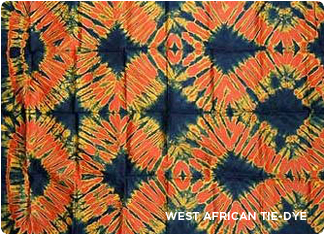 In Africa and India dyers were using imported RIT to decorate and imprint clothing. The process was a tied resist technique that utilized traditional patterns that had once been done with natural dyes, but the imported dye was much more predictable, economical and saved dyers a lot of time. Don decided to try and bring the tie-dye process to America in hopes it would catch on with a younger audience. In Africa and India dyers were using imported RIT to decorate and imprint clothing. The process was a tied resist technique that utilized traditional patterns that had once been done with natural dyes, but the imported dye was much more predictable, economical and saved dyers a lot of time. Don decided to try and bring the tie-dye process to America in hopes it would catch on with a younger audience.
The hippie movement was fast-growing; psychedelic colors were becoming the rage and people wanted ways to make their own individual clothing statement. So, Don went to Greenwich Village in New York City, an epicenter of the hippie movement, to try and ignite some interest in tie-dye. He recruited artists to experiment with the tie-dye process, but it was rather messy as the dye was meant to be simmered and multiple colors mixed and leaked. In response RIT packaged the dye products in liquid dispensers that could be squeezed onto fabric keeping the colors from running together so more intricate designs where possible.
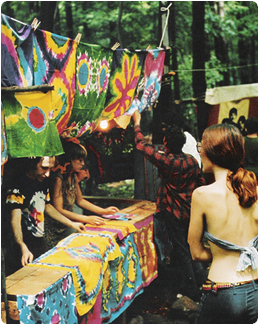 Artists, opinion leaders, and influencers took to tie-dying almost as if it were a new psychedelic substance. Janis Joplin began wearing tie dye (it was even rumored she wore tie-dye panties) but it was still confined to a small circle of users. The next stop was the fashion industry but they weren't convinced it was anything more then a local fad. About this time, folks heard about a musical gathering that was to take place in rural Woodstock, New York, and it was going to be a big event (understatement of the decade!). Two of the well-known artists in the Village wanted to tie-dye several hundred T-shirts and give them away at the concert. RIT financed the project. Thousands of people showed up at Woodstock from across the country and the tie-dye T-shirts were eye-catching. The idea caught on big. Joe Cocker, Mama Cass, Janis Joplin all wore tie-dye. Tie-dye became a symbol of antiestablishmentarianism, as no one else could have the same shirt as you even if they used the same colors. It was a statement of being an individual. After Woodstock, sales of RIT dye began to increase, but it was still in danger of being a fad that would quickly fizzle out. It was back to the fashion industry to try put tie-dye in the spot light. Artists, opinion leaders, and influencers took to tie-dying almost as if it were a new psychedelic substance. Janis Joplin began wearing tie dye (it was even rumored she wore tie-dye panties) but it was still confined to a small circle of users. The next stop was the fashion industry but they weren't convinced it was anything more then a local fad. About this time, folks heard about a musical gathering that was to take place in rural Woodstock, New York, and it was going to be a big event (understatement of the decade!). Two of the well-known artists in the Village wanted to tie-dye several hundred T-shirts and give them away at the concert. RIT financed the project. Thousands of people showed up at Woodstock from across the country and the tie-dye T-shirts were eye-catching. The idea caught on big. Joe Cocker, Mama Cass, Janis Joplin all wore tie-dye. Tie-dye became a symbol of antiestablishmentarianism, as no one else could have the same shirt as you even if they used the same colors. It was a statement of being an individual. After Woodstock, sales of RIT dye began to increase, but it was still in danger of being a fad that would quickly fizzle out. It was back to the fashion industry to try put tie-dye in the spot light.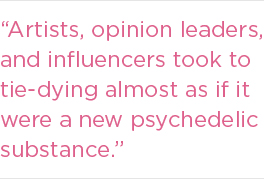
Only one fashion designer saw possibilities in tie-dye, but one is all it took. Roy Halston Frowick liked the tie-dye concept and took a chance on it. He sold to the likes of Cher, Catherine DeNeuve, and Ali McGraw. The big break came when Ali McGraw was featured on the cover of a major national magazine wearing Halston's tie-dye. Shortly after, Halston began using the tie-dye motif in many of his department store boutiques, and tie-dye took off as a bona fide fashion. 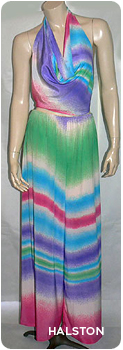 Next stop, Middle America. It doesn't get much more Middle America than the Girl Scouts. RIT went to the Girl Scouts and encouraged them to create a tie-dye merit badge. Sure enough, several months later, there was a Girl Scout tie-dye "Fun Patch". There were also several appearances on shows like Captain Kangaroo to capture the imagination of kids nation wide. Next stop, Middle America. It doesn't get much more Middle America than the Girl Scouts. RIT went to the Girl Scouts and encouraged them to create a tie-dye merit badge. Sure enough, several months later, there was a Girl Scout tie-dye "Fun Patch". There were also several appearances on shows like Captain Kangaroo to capture the imagination of kids nation wide.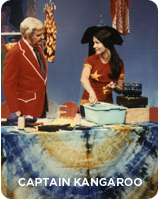
As tie-dye became more popular and folks started selling goods at concerts and festivals, people wanted a product that would hold up better to repeated washing. Brighter (even more psychedelic!) colors wouldn't hurt either! Around this time Fiber Reactive -MX type dyes were available under the brand name Procion, they where easy to use and worked with cool water (no more simmering!). You could easily apply multiple colors to the same shirt and batch them at room temperature now, and that was a huge improvement. They were also much more cost effective for mass production. Procion Dyes were developed by ICI, a British dye & chemical company and put on the market in 1956. They were actually trying to find a better type of dye to use on wool, but the dye turned out to be much more of a stellar performer on cotton. Soon other dye companies came out with their own versions of these dyes such as Cibacron, Remazol and Levafix, but these all needed hotter water, so did not take off for tie-dye. These cold water fiber reactive dyes are no longer made under the Procion brand name but many people still refer to them as Procion Dyes. Fiber Reactive MX dyes are still, to this day, one of the most widely used for dying cellulose fibers. Here are basic tie-dye directions with this dye.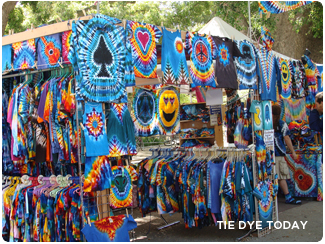
Over half a century (has it really been that long?!) later tie-dye is still a fun popular activity for families, camp groups, schools and is popular at festivals.
Recently tie-dye has gone back to its ethnic roots with a resurgence of interest in Shibori and natural dyeing techniques. Artists like Carter Smith have taken shibori/tie-dye to a whole new level working on silk and creating very detailed patterns and using bias cut garments.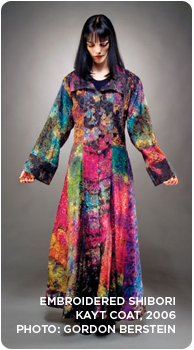
With the current resurgence in hand making crafts and DIY a new generation of dyers are chronicling their tie-dying experiments on blogs and photo sharing websites.
For More in depth reading on the tie-dye movement in America check out these links:
Rags Magazine Interview with Maureen Mubeem http://ragslives.blogspot.com/2006/10/june-1970-maureen-mubeem-tie-dye.html
Psychedelic beginnings- April 06, 200 by Erin Weinger, LA Times http://articles.latimes.com/2008/apr/06/image/ig-lookback6
|












 It all started back in the 60s as an attempt to save a brand name. At the time, RIT® dye was starting to lose it's market; primarily older women that dyed home goods. RIT was (and still is) mainly sold through supermarkets and craft stores. The management at RIT was faced with the challenge of trying to save the brand without spending much money to do so. The manager of RIT at the time, Don Price, determined to find an entirely new use for RIT dye and save the brand.
It all started back in the 60s as an attempt to save a brand name. At the time, RIT® dye was starting to lose it's market; primarily older women that dyed home goods. RIT was (and still is) mainly sold through supermarkets and craft stores. The management at RIT was faced with the challenge of trying to save the brand without spending much money to do so. The manager of RIT at the time, Don Price, determined to find an entirely new use for RIT dye and save the brand. In Africa and India dyers were using imported RIT to decorate and imprint clothing. The process was a tied resist technique that utilized traditional patterns that had once been done with natural dyes, but the imported dye was much more predictable, economical and saved dyers a lot of time. Don decided to try and bring the tie-dye process to America in hopes it would catch on with a younger audience.
In Africa and India dyers were using imported RIT to decorate and imprint clothing. The process was a tied resist technique that utilized traditional patterns that had once been done with natural dyes, but the imported dye was much more predictable, economical and saved dyers a lot of time. Don decided to try and bring the tie-dye process to America in hopes it would catch on with a younger audience. Artists, opinion leaders, and influencers took to tie-dying almost as if it were a new psychedelic substance. Janis Joplin began wearing tie dye (it was even rumored she wore tie-dye panties) but it was still confined to a small circle of users. The next stop was the fashion industry but they weren't convinced it was anything more then a local fad. About this time, folks heard about a musical gathering that was to take place in rural Woodstock, New York, and it was going to be a big event (understatement of the decade!). Two of the well-known artists in the Village wanted to tie-dye several hundred T-shirts and give them away at the concert. RIT financed the project. Thousands of people showed up at Woodstock from across the country and the tie-dye T-shirts were eye-catching. The idea caught on big. Joe Cocker, Mama Cass, Janis Joplin all wore tie-dye. Tie-dye became a symbol of antiestablishmentarianism, as no one else could have the same shirt as you even if they used the same colors. It was a statement of being an individual. After Woodstock, sales of RIT dye began to increase, but it was still in danger of being a fad that would quickly fizzle out. It was back to the fashion industry to try put tie-dye in the spot light.
Artists, opinion leaders, and influencers took to tie-dying almost as if it were a new psychedelic substance. Janis Joplin began wearing tie dye (it was even rumored she wore tie-dye panties) but it was still confined to a small circle of users. The next stop was the fashion industry but they weren't convinced it was anything more then a local fad. About this time, folks heard about a musical gathering that was to take place in rural Woodstock, New York, and it was going to be a big event (understatement of the decade!). Two of the well-known artists in the Village wanted to tie-dye several hundred T-shirts and give them away at the concert. RIT financed the project. Thousands of people showed up at Woodstock from across the country and the tie-dye T-shirts were eye-catching. The idea caught on big. Joe Cocker, Mama Cass, Janis Joplin all wore tie-dye. Tie-dye became a symbol of antiestablishmentarianism, as no one else could have the same shirt as you even if they used the same colors. It was a statement of being an individual. After Woodstock, sales of RIT dye began to increase, but it was still in danger of being a fad that would quickly fizzle out. It was back to the fashion industry to try put tie-dye in the spot light.
 Next stop, Middle America. It doesn't get much more Middle America than the Girl Scouts. RIT went to the Girl Scouts and encouraged them to create a tie-dye merit badge. Sure enough, several months later, there was a Girl Scout tie-dye "Fun Patch". There were also several appearances on shows like Captain Kangaroo to capture the imagination of kids nation wide.
Next stop, Middle America. It doesn't get much more Middle America than the Girl Scouts. RIT went to the Girl Scouts and encouraged them to create a tie-dye merit badge. Sure enough, several months later, there was a Girl Scout tie-dye "Fun Patch". There were also several appearances on shows like Captain Kangaroo to capture the imagination of kids nation wide.




